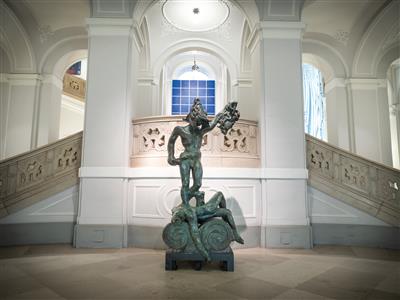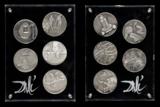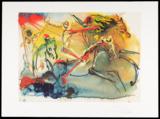Salvador Dali *

(Figueras 1904–1989)
Persée – Hommage à Benvenuto Cellini, c. 1976, signed and numbered, this work is number 2 from an edition of 8 + 4 a. p. numbered from EA I/IV to EA IV/IV Fonderie F. lli Bonvicini, Italy, patinated bronze, 252 x 130 x 110 cm
The work is registered in the Archives Descharnes under no. 0–272 and is accompanied by photo-certificate of authenticity.
Provenance:
European Private Collection
Exhibited:
Venice, Chiesa di San Bartolomeo, June–November 1995
Città di San Marino, Salvador Dalí. Sculture originali inedite, opere di grafica, Palazzo Pergami-Belluzzi, 14 June – 15 September 1996, exh. cat.
Venice, Scuola Sant’Apollonia, 1997
Rome, Chiesa di Santa Maria del Popolo, Sala del Bramante, March – November 1998
Florence, Museo Santa Croce, 1998
Sylt, Stadtgalerie Alte Post, 1998
Rome, Galleria Colonna (Galleria Alberto Sordi), 1998
Ischia, Terme di Ischia, 2002
Naples, Città della Scienza, 2004 Portoferraio Isola d’Elba, Salvador Dalí. Piacere e complessità di un genio, Centro Congressuale
“De Laugier”, 19 June – 29 August 2004
Milan, Salvador Dalí. Piacere e complessità di un genio, Chiesa di San Paolo Converso, 18 December 2004 – 8 March 2005
Santiago de Chile, Centro Cultural Estación Mapocho, 2005 Reggio Calabria, Salvador Dalí. Piacere e complessità di un genio, July – September 2006
Porto, Palacio de Freixo, July – November 2007
Catania, Centro culturale “Le Ciminiere”, 9 February – 2 April 2008
Messina, Expo Center, 2009
Milan, Salvador Dalí. Piacere e complessità di un genio, Chiesa di San Paolo Converso, 22 October – 15 December 2012
Bruges, Museum-Gallery Xpo Salvador Dalí, 2014 – 2018
Literature:
R. and N. Descharnes, Dalí, Le dur et le mou. Sculptures & Objets, Eccart, France 2003, p. 173, no. 434 with ill.
The forty-four sculptures in the Clot Collection were created between 1969 and 1979 in the artist’s summer residence in Port Lligat. Here at the end of every morning, having laid down his brushes and left the atelier for the poolside, Dalí was busy modelling his waxes until he joined his wife Gala for lunch. A real daily ritual developed with the intention of making the most of the hottest hours of the day, since the heat made it extremely easy to model the fine block of white wax: “une fois les quelques mètres de cire déroulés, on pouvait observer un habile jeu de mains opérant de savants pliages plutôt qu’un veritable modelage. J’assistais à la naissance d’un nouvel art de sculpter, le pliage ou origami dalinien!” [Once a few meters of wax were rolled out, it was possible to watch a skilful play of hands, wisely folding instead of true modelling. I was in the presence of a new art of sculpting: ‘folding’ or Dalínian origami], recalls Robert Descharnes, a frequent guest at the Port Lligat house.
The variety of sculptural subjects reflects the artist’s boundless creative universe, within which, however, it is possible to recognise three main themes: Surrealism, with reference to Duchamp and Freud, which is reflected in the tendency to include double or triple images in a single form. Classicism, which the artist approached for the first time in the early 1930s during his youth, through the study of the famous Greek canons of the human body, and which deeply fascinated him during his trip to Italy. Finally, religion, which predominated in Dalí’s life from his childhood onwards. The search for divine grace nourished by the rich Christian iconography did not cease to guide the artist’s hand in painting Christ, angels and Madonnas, which became as popular as his eccentric characters.
Enjoying a phenomenal visual memory and a sure hand, Dalí soon began to master the theoretical knowledge acquired during his studies: “Nothing could be easier at that point than to find the curves of Aphrodite or Apollo leading the chariot of the Sun. In the Clot collection, Dalí’s fascination with Antiquity is embodied in the Triton, the dolphin he sees rising from the waves in front of his house; Icarus, precursor of the first flying machines; the beautiful Apollo and his procession of Muses; the mythological horses of the Acropolis of Athens. It is also takes the shape of Mercury and his symbolic caduceus; Perseus victorious over the terrible Medusa; monsters and enigmatic deities; the Roman Emperor Trajan riding from Seville to Roman Dacia”. (R. and N. Descharnes, Dalì. Le dur et le mou. Sculptures & Objets, Eccart, France 2003, p. 159)
In various works in the collection, the classical and the Christian-medieval worlds meet and mingle, in an enriching context of constant experimentation. In the equestrian group of the Guerrier triomphant, for example, Dalí imagines a warrior knight, a figure as important to the classical world as to Christian iconography, in the moment before falling on the battlefield or in combat, shown through the shield brandished high to suggest the idea of defence against an enemy.
Fully linked to the theme of the recovery of classicism is Perseus, which is, in the proud words of the artist, his most important sculptural work. Dalí’s Perseus is a copy of the Perseus of Benvenuto Cellini, commissioned by Cosimo I de Medici to be placed inside the Loggia dei Lanzi in Florence. The work can be considered a tribute to the Florentine sculptor, poet and writer whose technical and aesthetic skills and artistic versatility Dalí admired. The whole group is an allegory of the triumph of human harmony and self-knowledge. Cellini shapes some allegorical elements of the narrative with greater technical refinement, adding to the sculptural group almost all details of the myth, from the head of the decapitated Medusa, to the flying sandals, to the Gorgon’s head case, to the scythe donated by Hermes; Dalí, on the contrary, gives greater importance to the figure of Perseus, highlighting the values that mythology attributes to the son of Zeus as a hero: nobility, courage and wisdom. He therefore models the attributes he considered the most important, for example the helmet which, altered in its proportions with respect to the original statue, emphasises the myth, almost making the hero’s face disappear in a maze of snakes.
Made for the Catalan art lover Isidro Clot, the 44 pieces in the collection are the only three-dimensional pieces in the artist’s oeuvre made entirely by his hand. These are among the highest expressions of Salvador Dalí’s sculpture, which, free from desires or constraints imposed by the client, show a real creative freedom, emphasising the prominent position that these sculptures occupy in his artistic output.
They were created in a flow, without any chronological order or precise distribution, according to the inspiration and creativity of the artist. It was Dalí’s intention that they should be made in several series. This project was partly realised by Isidro Clot and his son-in-law Andres Campos at their Diejasa foundry, where they created a few editions, starting with a bronze series in the original format. Two of these were offered to the artist and to the Salvador Dalí Museum in St. Petersburg, Florida.
The first item of the series to be created was Gala Gradiva, dedicated to the artist’s inspiring muse, his wife Gala, who crosses this wax poem, sometimes lending her face, sometimes her body to several figures, as a goddess, a Madonna, or a novel’s heroine. The last item was Head of a Warrior, a double image inspired by the Italian Renaissance that Dalí so admired.
The forty-four pieces in the Clot collection embody a wide poetic vision sculpted in the thin layers of wax moulded under the sun of Port Lligat, offering us a glimpse of Salvador Dalí’s boundless fantastical uni--verse.
Esperto: Alessandro Rizzi
 Alessandro Rizzi
Alessandro Rizzi
+39-02-303 52 41
alessandro.rizzi@dorotheum.it
23.06.2020 - 16:00
- Prezzo realizzato: **
-
EUR 271.700,-
- Stima:
-
EUR 90.000,- a EUR 120.000,-
Salvador Dali *
(Figueras 1904–1989)
Persée – Hommage à Benvenuto Cellini, c. 1976, signed and numbered, this work is number 2 from an edition of 8 + 4 a. p. numbered from EA I/IV to EA IV/IV Fonderie F. lli Bonvicini, Italy, patinated bronze, 252 x 130 x 110 cm
The work is registered in the Archives Descharnes under no. 0–272 and is accompanied by photo-certificate of authenticity.
Provenance:
European Private Collection
Exhibited:
Venice, Chiesa di San Bartolomeo, June–November 1995
Città di San Marino, Salvador Dalí. Sculture originali inedite, opere di grafica, Palazzo Pergami-Belluzzi, 14 June – 15 September 1996, exh. cat.
Venice, Scuola Sant’Apollonia, 1997
Rome, Chiesa di Santa Maria del Popolo, Sala del Bramante, March – November 1998
Florence, Museo Santa Croce, 1998
Sylt, Stadtgalerie Alte Post, 1998
Rome, Galleria Colonna (Galleria Alberto Sordi), 1998
Ischia, Terme di Ischia, 2002
Naples, Città della Scienza, 2004 Portoferraio Isola d’Elba, Salvador Dalí. Piacere e complessità di un genio, Centro Congressuale
“De Laugier”, 19 June – 29 August 2004
Milan, Salvador Dalí. Piacere e complessità di un genio, Chiesa di San Paolo Converso, 18 December 2004 – 8 March 2005
Santiago de Chile, Centro Cultural Estación Mapocho, 2005 Reggio Calabria, Salvador Dalí. Piacere e complessità di un genio, July – September 2006
Porto, Palacio de Freixo, July – November 2007
Catania, Centro culturale “Le Ciminiere”, 9 February – 2 April 2008
Messina, Expo Center, 2009
Milan, Salvador Dalí. Piacere e complessità di un genio, Chiesa di San Paolo Converso, 22 October – 15 December 2012
Bruges, Museum-Gallery Xpo Salvador Dalí, 2014 – 2018
Literature:
R. and N. Descharnes, Dalí, Le dur et le mou. Sculptures & Objets, Eccart, France 2003, p. 173, no. 434 with ill.
The forty-four sculptures in the Clot Collection were created between 1969 and 1979 in the artist’s summer residence in Port Lligat. Here at the end of every morning, having laid down his brushes and left the atelier for the poolside, Dalí was busy modelling his waxes until he joined his wife Gala for lunch. A real daily ritual developed with the intention of making the most of the hottest hours of the day, since the heat made it extremely easy to model the fine block of white wax: “une fois les quelques mètres de cire déroulés, on pouvait observer un habile jeu de mains opérant de savants pliages plutôt qu’un veritable modelage. J’assistais à la naissance d’un nouvel art de sculpter, le pliage ou origami dalinien!” [Once a few meters of wax were rolled out, it was possible to watch a skilful play of hands, wisely folding instead of true modelling. I was in the presence of a new art of sculpting: ‘folding’ or Dalínian origami], recalls Robert Descharnes, a frequent guest at the Port Lligat house.
The variety of sculptural subjects reflects the artist’s boundless creative universe, within which, however, it is possible to recognise three main themes: Surrealism, with reference to Duchamp and Freud, which is reflected in the tendency to include double or triple images in a single form. Classicism, which the artist approached for the first time in the early 1930s during his youth, through the study of the famous Greek canons of the human body, and which deeply fascinated him during his trip to Italy. Finally, religion, which predominated in Dalí’s life from his childhood onwards. The search for divine grace nourished by the rich Christian iconography did not cease to guide the artist’s hand in painting Christ, angels and Madonnas, which became as popular as his eccentric characters.
Enjoying a phenomenal visual memory and a sure hand, Dalí soon began to master the theoretical knowledge acquired during his studies: “Nothing could be easier at that point than to find the curves of Aphrodite or Apollo leading the chariot of the Sun. In the Clot collection, Dalí’s fascination with Antiquity is embodied in the Triton, the dolphin he sees rising from the waves in front of his house; Icarus, precursor of the first flying machines; the beautiful Apollo and his procession of Muses; the mythological horses of the Acropolis of Athens. It is also takes the shape of Mercury and his symbolic caduceus; Perseus victorious over the terrible Medusa; monsters and enigmatic deities; the Roman Emperor Trajan riding from Seville to Roman Dacia”. (R. and N. Descharnes, Dalì. Le dur et le mou. Sculptures & Objets, Eccart, France 2003, p. 159)
In various works in the collection, the classical and the Christian-medieval worlds meet and mingle, in an enriching context of constant experimentation. In the equestrian group of the Guerrier triomphant, for example, Dalí imagines a warrior knight, a figure as important to the classical world as to Christian iconography, in the moment before falling on the battlefield or in combat, shown through the shield brandished high to suggest the idea of defence against an enemy.
Fully linked to the theme of the recovery of classicism is Perseus, which is, in the proud words of the artist, his most important sculptural work. Dalí’s Perseus is a copy of the Perseus of Benvenuto Cellini, commissioned by Cosimo I de Medici to be placed inside the Loggia dei Lanzi in Florence. The work can be considered a tribute to the Florentine sculptor, poet and writer whose technical and aesthetic skills and artistic versatility Dalí admired. The whole group is an allegory of the triumph of human harmony and self-knowledge. Cellini shapes some allegorical elements of the narrative with greater technical refinement, adding to the sculptural group almost all details of the myth, from the head of the decapitated Medusa, to the flying sandals, to the Gorgon’s head case, to the scythe donated by Hermes; Dalí, on the contrary, gives greater importance to the figure of Perseus, highlighting the values that mythology attributes to the son of Zeus as a hero: nobility, courage and wisdom. He therefore models the attributes he considered the most important, for example the helmet which, altered in its proportions with respect to the original statue, emphasises the myth, almost making the hero’s face disappear in a maze of snakes.
Made for the Catalan art lover Isidro Clot, the 44 pieces in the collection are the only three-dimensional pieces in the artist’s oeuvre made entirely by his hand. These are among the highest expressions of Salvador Dalí’s sculpture, which, free from desires or constraints imposed by the client, show a real creative freedom, emphasising the prominent position that these sculptures occupy in his artistic output.
They were created in a flow, without any chronological order or precise distribution, according to the inspiration and creativity of the artist. It was Dalí’s intention that they should be made in several series. This project was partly realised by Isidro Clot and his son-in-law Andres Campos at their Diejasa foundry, where they created a few editions, starting with a bronze series in the original format. Two of these were offered to the artist and to the Salvador Dalí Museum in St. Petersburg, Florida.
The first item of the series to be created was Gala Gradiva, dedicated to the artist’s inspiring muse, his wife Gala, who crosses this wax poem, sometimes lending her face, sometimes her body to several figures, as a goddess, a Madonna, or a novel’s heroine. The last item was Head of a Warrior, a double image inspired by the Italian Renaissance that Dalí so admired.
The forty-four pieces in the Clot collection embody a wide poetic vision sculpted in the thin layers of wax moulded under the sun of Port Lligat, offering us a glimpse of Salvador Dalí’s boundless fantastical uni--verse.
Esperto: Alessandro Rizzi
 Alessandro Rizzi
Alessandro Rizzi
+39-02-303 52 41
alessandro.rizzi@dorotheum.it
|
Hotline dell'acquirente
lun-ven: 10.00 - 17.00
kundendienst@dorotheum.at +43 1 515 60 200 |
| Asta: | Arte moderna |
| Tipo d'asta: | Asta in sala |
| Data: | 23.06.2020 - 16:00 |
| Luogo dell'asta: | Wien | Palais Dorotheum |
| Esposizione: | 18.06. - 23.06.2020 |
** Prezzo d’acquisto comprensivo dei diritti d’asta acquirente e IVA
Non è più possibile effettuare un ordine di acquisto su Internet. L'asta è in preparazione o è già stata eseguita.
Altri oggetti dell'artista
-

Prezzo di partenza:
EUR 2.200,- -

Prezzo di partenza:
EUR 500,- -

Prezzo di partenza:
EUR 500,-
